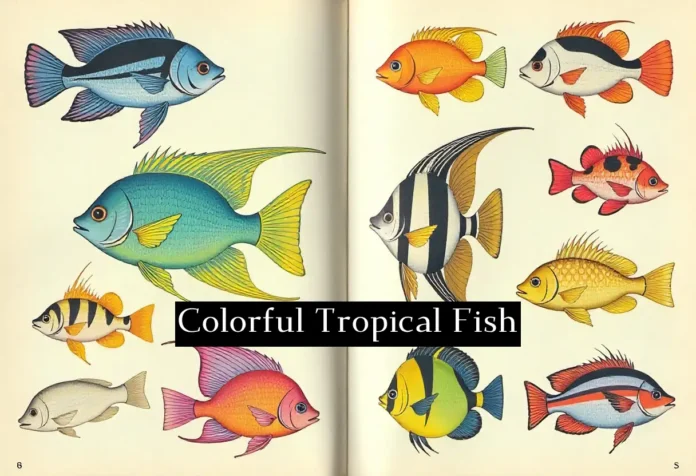Picture a living canvas where electric blues dance beside vibrant reds, while golden yellows shimmer against deep emerald greens. That’s the magic of colorful tropical fish. These underwater gems transform any aquarium into a breathing work of art that captivates everyone who sees it.
Around 10 percent of British households own pet fish, making them the third most popular animal to welcome into our homes after cats and dogs. The hobby continues to grow because these fish offer more than just beauty—they bring tranquility, reduce stress, and create a focal point that naturally draws the eye.
This guide covers everything you need to know about the most stunning species available, their care requirements, and how to create the perfect environment for them to thrive.
Colorful tropical fish include species like Neon Tetras with electric blue stripes, Discus with turquoise patterns, Betta fish in vivid reds, Guppies with rainbow tails, and African Cichlids in brilliant yellows. Most require 75-80°F water, proper filtration, and compatible tank mates to display their full colors.
Most Popular Colorful Tropical Fish
Freshwater Species That Steal the Show
Neon Tetras remain the world’s most popular choice for good reason. These tiny fish display bright red and blue coloring and their ease of care makes them a winning combination for beginners. They grow to just 1.5 inches and thrive in schools of 10-15 fish.
Betta fish are an iconic colorful tropical fish with brightly colored, energetic personalities and beautiful flowing fins. These freshwater fish from Southeast Asia have grown in popularity over the last several years. Males display stunning solid reds, blues, and even metallic colors. However, their territorial nature means only one male per tank.
Discus fish represent the pinnacle of aquarium keeping. Also known as the Pompadour Fish, the Discus is native to the Amazon River in Brazil and is highly sought after by aquariasts due to the dazzling array of colors different fish exhibit—from vivid orange to metallic turquoise. They require advanced care but reward dedicated owners with breathtaking displays.
Guppies offer incredible variety without demanding expertise. With their alternative name of the Rainbow Fish, Guppies have been selectively bred to come in a range of colors—all stunning. Originally from northeast South America, they give birth to live babies. Their hardy nature makes them perfect for beginners.
African Cichlids: Nature’s Bold Statement
Lake Malawi cichlids bring marine-quality colors to freshwater tanks. These tropical freshwater fish come from a lake that acts more like the sea with waves, deep, clear water, rocky cliffs and sandy beaches. What the lake provides is variety, with bright yellow and bright blue—two colors which are rare in tropical fish in nature.
Electric Yellow Labs live up to their name with solid lemon-yellow bodies. They’re less aggressive than many African species but still need appropriate tank mates.
Peacock Cichlids come in every color imaginable. Blues, reds, yellows, and even albino varieties exist. Males display more intense colors, especially during breeding.
Rainbow Brilliance
Boeseman’s Rainbowfish is famous for its stunning graduated coloration, progressing from a metallic blue front half to a golden-yellow back. A peaceful fish, they thrive in community aquariums. They need space to swim and look best in groups of six or more.
Bottom Dwellers With Personality
Clown Loaches have one of the most aesthetically pleasing patterns you can find. The orange bodies and thick black bands make them extremely pretty without being too noisy. They can reach 12 inches, so plan for a large tank. Their playful antics and social nature make them worth the space.
Cherry Barbs add rich red tones to the mid-level of your tank. They’re peaceful schooling fish that work well in community setups. Groups of six show natural behaviors and reduce stress.
Setting Up Your Tropical Aquarium
Tank Size Matters More Than You Think
Smaller tanks are more prone to temperature and water quality fluctuations, which may stress your fish. Start with at least a 20-gallon tank. Bigger truly is better—a 40-55 gallon tank gives you more options and forgives beginner mistakes.
A standard rectangular shape beats fancy designs. They are far easier to clean, and the surface area allows for better gas exchange, which keeps your oxygen levels higher, and in turn, your fish healthier.
Essential Equipment Checklist
| Equipment | Purpose | Specifications |
|---|---|---|
| Heater | Maintains temperature | Tropical fish typically require water temperatures between 75-80°F (24-27°C) |
| Filter | Removes waste | Appropriate for tank size |
| Lighting | Shows colors, supports plants | 8-12 hours daily |
| Thermometer | Monitors temperature | Digital or stick-on type |
| Substrate | Provides a base for plants | Gravel or sand |
| Water conditioner | Removes chlorine | Used with every water change |
We suggest 1W per 1L of water, so a 100L tank requires a 100W heater. This ensures consistent heating without cold spots.
The Nitrogen Cycle: Your Tank’s Foundation
Never add fish immediately. The nitrogen cycle must be established first. This process takes 4-6 weeks. A cycling tank should have ammonia at 0ppm, nitrite at 0ppm, and nitrate at less than 40ppm.
Test your water every three days during the first six weeks. Once established, weekly testing catches problems early. Ammonia and nitrite are toxic—any reading above zero means your cycle isn’t complete.
Choosing Compatible Fish
Community Tank Guidelines
Not all colorful species play well together. Shoaling species should always be kept in groups, which will help to keep them stimulated and display natural behaviors. Research each species before mixing.
Safe Community Combinations:
- Neon Tetras with Cherry Barbs and Corydoras Catfish
- Guppies with Platies and Mollies
- Rainbowfish with larger tetras and peaceful bottom dwellers
Avoid These Pairings:
- Bettas with other bettas or similar-looking fish
- Large cichlids with small tetras
- Fast swimmers with slow-moving species
Stocking Density Rules
Follow the one-inch-of-fish-per-gallon guideline for most species. A 40-gallon tank holds approximately 30-35 inches of adult fish. Always account for maximum adult size, not current size.
Overstocking leads to poor water quality, stunted growth, and aggressive behavior. When in doubt, stock fewer fish.
Maintaining Peak Colors
Nutrition Makes the Difference
Tropical fish need a variety of pelleted and frozen foods to stay healthy. Different species prefer to eat in different ways: surface, middle or bottom swimmers. The position of their mouth indicates feeding preferences.
Quality flake food forms the base diet. Supplement with:
- Frozen bloodworms (high protein)
- Brine shrimp (enhances colors)
- Vegetable matter (for herbivores)
- Color-enhancing pellets with carotenoids
Feed small amounts twice daily. Remove uneaten food after five minutes to prevent water quality issues.
Water Quality: The Secret to Vibrant Colors
Perform 25% water changes every two weeks minimum. Performing regular water changes will reduce the nitrate levels and keep your tropical fish happy and healthy. Poor water quality dulls colors and stresses fish.
Test parameters weekly:
- pH: 6.8-7.2 for most species
- Ammonia: 0 ppm
- Nitrite: 0 ppm
- Nitrate: Below 40 ppm
Use a water conditioner every time you add tap water. Tap water contains chlorine and other chemicals harmful to fish.
Lighting for Maximum Impact
Proper lighting brings out the best in colorful fish. LED lights offer energy efficiency and adjustable spectrum. Please ensure lights are on for no longer than 8 hours per day and bulbs need to be changed every 6 to 8 months. This prevents excessive algae while showcasing fish colors.
Position tanks away from windows. Direct sunlight can cause excessive algae growth. Natural sunlight also creates temperature spikes that stress fish.
Common Health Issues
Recognizing Problems Early
Common signs of sickness in fish include changes in behavior or unusual spots or markings on your fish. Watch for:
- Loss of appetite
- Clamped fins
- White spots (ich)
- Rapid breathing
- Hiding constantly
Early detection means easier treatment. However, Betta fish aren’t as easy to look after as some may think, and are notoriously mistreated in the fish industry. Research the specific species needs thoroughly.
Quarantine Protocol
Keep a separate quarantine tank ready. If one of your fish has contracted an infection, the whole tank is at risk. It’s recommended to have a quarantine tank with cycled water to house the unwell fish and reduce the spread of infection. A 10-gallon tank works for most situations.
Advanced Color Enhancement
Selective Breeding Benefits
Humans have created hundreds more color strains of popular fish like goldfish, guppies, Discus and angelfish so that now, no matter how large or small your aquarium, you can have all the colors of the rainbow represented in your fish. Modern breeding produces colors never seen in wild populations.
Environmental Factors
Stress fades colors quickly. Reduce stress by:
- Maintaining stable water parameters
- Providing adequate hiding spots
- Avoiding aggressive tank mates
- Keeping appropriate group sizes
- Following proper acclimation procedures
Dark substrate intensifies fish colors. Light substrate makes them appear washed out. Plants create natural shelter and reduce stress.
Frequently Asked Questions
What are the easiest colorful tropical fish for beginners?
Guppies, Platies, and Neon Tetras offer brilliant colors with minimal care requirements. They tolerate minor water quality issues better than sensitive species.
How long do colorful tropical fish live?
Lifespan varies with species, but some can live for 10-12 years. Proper care significantly extends longevity. Bettas typically live 3-5 years, while Discus can reach 10-15 years.
Can I mix saltwater and freshwater tropical fish?
No. Saltwater and freshwater fish require completely different water chemistry. Clownfish are saltwater fish, so they require more effort than other freshwater fish. Never combine them.
Why are my fish losing their colors?
Stress, poor diet, inadequate lighting, or water quality issues cause color loss. Test water parameters first, then evaluate diet and tank mates.
Do tropical fish need special lighting?
Yes. Different types of bulbs can enhance the colors of fish and promote plant growth. LED lights designed for aquariums work best. Avoid leaving lights on constantly.
Building Your Dream Tank
Start small and research thoroughly. Not all tropical species can live together. Fish that swim fast may bully slower swimmers, whilst having too many surface dwellers will cause a build-up of debris on your tank’s floor. Plan your community carefully.
Success comes from patience. Cycle your tank properly, add fish gradually, and maintain consistent care. The reward is a thriving underwater ecosystem that displays nature’s most brilliant colors every single day. Your living room can house a piece of the Amazon, Lake Malawi, or Southeast Asian streams—complete with fish that rival any tropical sunset.



